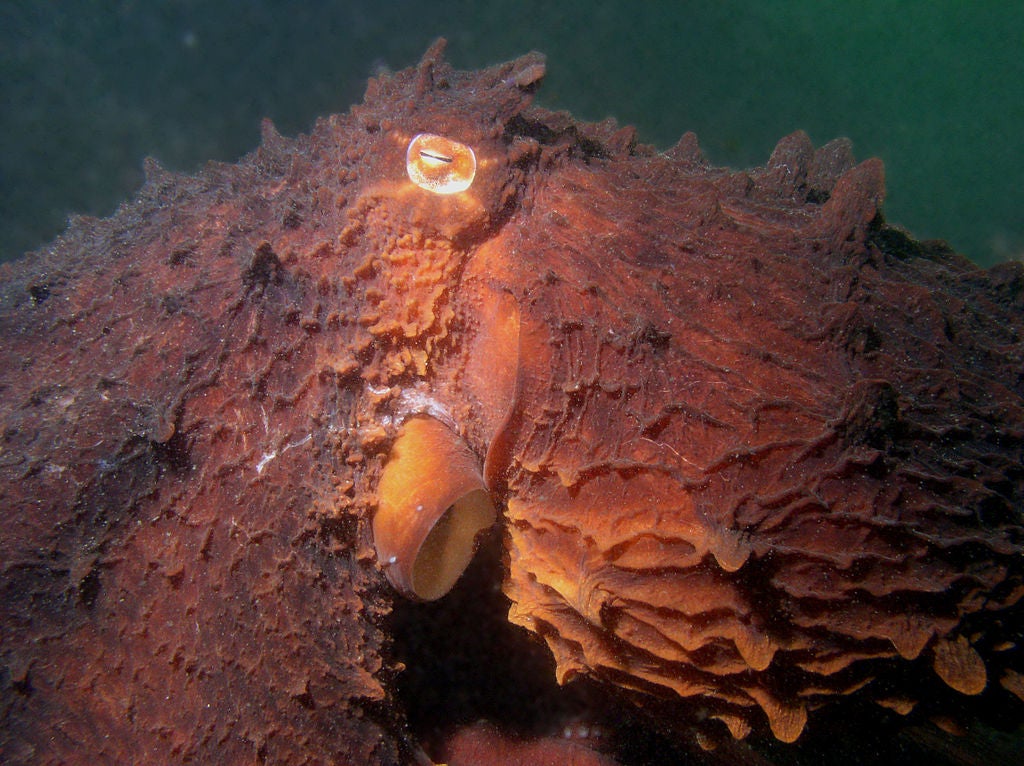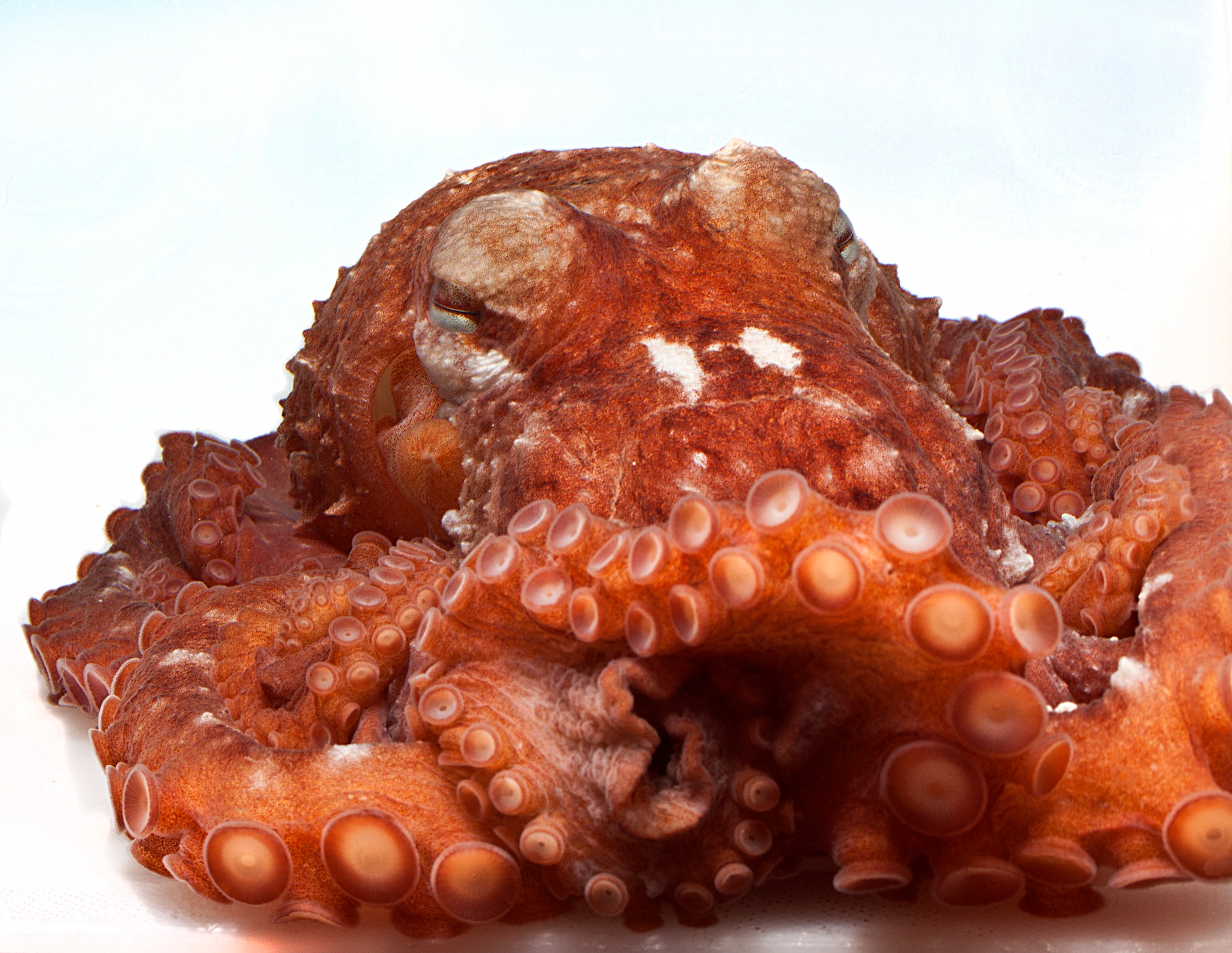
You wouldn’t think a giant octopus could hide in plain sight for decades. But researchers have now learned that the giant Pacific octopus (GPO)—the largest known octopus on Earth, ranging from California to Alaska to Japan—is actually two species. Now that we’ve been properly introduced to the new “frilled giant octopus,” we’ll need to learn more about it to ensure its survival.
This discovery isn’t a total surprise. Scientists have suspected for decades that giant Pacific octopus might be an “umbrella name” covering more than one species. In 2012, researchers from Alaska Pacific University and the US Geological Survey found a genetically distinct group of GPOs in Prince William Sound. Unfortunately, they’d collected only small snips of arm tissue for DNA analysis before returning the octopuses to the wild, so they couldn’t find out whether the two groups might be visually distinct as well. So Nathan Hollenbeck, an undergraduate student at Alaska Pacific University, tackled these cryptic creatures for his senior thesis by looking at shrimp fishing bycatch, where the octopuses commonly turn up.
Shrimp fishers in Alaska lower baited pots into the water, let them sit for up to a day, then retrieve them to get the shrimp that have climbed in. Occasionally a giant octopus will climb in too—perhaps interested in the bait, or perhaps simply investigating crevices, as octopuses are wont to do. “Usually the octopuses have eaten the shrimp,” Hollenbeck told Earther, “so there’s a lot of shrimp shells and legs and antennae.”
Hollenbeck quickly found that he could identify two kinds of giant octopus just by looking at them. One was the familiar GPO; the other sported a distinctive frill along the length of its body. These frilled octopuses also exhibited curious “eyelashes” of raised skin, and bore two white spots on the front of the head, where GPOs have only one.
To confirm that the visually distinct group matched the genetically distinct one, Hollenbeck cut off tiny pieces of the octopuses’ arms. And because he wanted to know if future work could avoid this invasive sampling technique, he also collected DNA by swiping the octopuses’ skin with cotton swabs.
“Presumably, people have been catching these octopuses for years and no one ever noticed”
You'd probably prefer that a doctor swab your cheek rather than stick a needle in your arm—or snip off the tip of a finger. (At least octopus arms regenerate.) Other animals probably share this preference. Scientists routinely use non-invasive sampling techniques on mammals and birds, but Hollenbeck was the first to try swabbing an octopus. It worked like a charm, and DNA from arm tips and swabs agreed: the frilled octopus is a separate species from the GPO. Hollenbeck and his advisor David Scheel published their results in November in the American Malacological Bulletin.
“Presumably, people have been catching these octopuses for years and no one ever noticed,” Scheel said. Frilled giant octopuses appear to be less widely distributed than GPOs—Hollenbeck and Scheel have collected reliable reports of the species only from Juneau to the Bering Sea. They also seem to prefer deeper water, unfrequented by tidepoolers or scuba divers. In this habitat, though, they might be fairly common. Frilled giants made up a third of octopus bycatch in Hollenbeck’s shrimp pots.
Crab and cod are also fished with pots in the Gulf of Alaska, and it’s likely that many of the octopuses caught in these pots will turn out to be frilled giants, too. No one knows whether that poses a threat to the species’ survival.
Even for GPOs, we don’t have enough information to determine whether they’re at risk of overfishing. Government scientists at the Alaska Fisheries Science Center recommend “very conservative” management “due to the poor state of knowledge of the species composition, life history, distribution, and abundance of octopus” in the Gulf of Alaska.

.
.
Source-gizmodo
 You wouldn’t think a giant octopus could hide in plain sight for decades. But researchers have now learned that the giant Pacific octopus (GPO)—the largest known octopus on Earth, ranging from California to Alaska to Japan—is actually two species. Now that we’ve been properly introduced to the new “frilled giant octopus,” we’ll need to learn more about it to ensure its survival.
This discovery isn’t a total surprise. Scientists have suspected for decades that giant Pacific octopus might be an “umbrella name” covering more than one species. In 2012, researchers from Alaska Pacific University and the US Geological Survey found a genetically distinct group of GPOs in Prince William Sound. Unfortunately, they’d collected only small snips of arm tissue for DNA analysis before returning the octopuses to the wild, so they couldn’t find out whether the two groups might be visually distinct as well. So Nathan Hollenbeck, an undergraduate student at Alaska Pacific University, tackled these cryptic creatures for his senior thesis by looking at shrimp fishing bycatch, where the octopuses commonly turn up.
Shrimp fishers in Alaska lower baited pots into the water, let them sit for up to a day, then retrieve them to get the shrimp that have climbed in. Occasionally a giant octopus will climb in too—perhaps interested in the bait, or perhaps simply investigating crevices, as octopuses are wont to do. “Usually the octopuses have eaten the shrimp,” Hollenbeck told Earther, “so there’s a lot of shrimp shells and legs and antennae.”
Hollenbeck quickly found that he could identify two kinds of giant octopus just by looking at them. One was the familiar GPO; the other sported a distinctive frill along the length of its body. These frilled octopuses also exhibited curious “eyelashes” of raised skin, and bore two white spots on the front of the head, where GPOs have only one.
To confirm that the visually distinct group matched the genetically distinct one, Hollenbeck cut off tiny pieces of the octopuses’ arms. And because he wanted to know if future work could avoid this invasive sampling technique, he also collected DNA by swiping the octopuses’ skin with cotton swabs.
“Presumably, people have been catching these octopuses for years and no one ever noticed”
You'd probably prefer that a doctor swab your cheek rather than stick a needle in your arm—or snip off the tip of a finger. (At least octopus arms regenerate.) Other animals probably share this preference. Scientists routinely use non-invasive sampling techniques on mammals and birds, but Hollenbeck was the first to try swabbing an octopus. It worked like a charm, and DNA from arm tips and swabs agreed: the frilled octopus is a separate species from the GPO. Hollenbeck and his advisor David Scheel published their results in November in the American Malacological Bulletin.
“Presumably, people have been catching these octopuses for years and no one ever noticed,” Scheel said. Frilled giant octopuses appear to be less widely distributed than GPOs—Hollenbeck and Scheel have collected reliable reports of the species only from Juneau to the Bering Sea. They also seem to prefer deeper water, unfrequented by tidepoolers or scuba divers. In this habitat, though, they might be fairly common. Frilled giants made up a third of octopus bycatch in Hollenbeck’s shrimp pots.
Crab and cod are also fished with pots in the Gulf of Alaska, and it’s likely that many of the octopuses caught in these pots will turn out to be frilled giants, too. No one knows whether that poses a threat to the species’ survival.
Even for GPOs, we don’t have enough information to determine whether they’re at risk of overfishing. Government scientists at the Alaska Fisheries Science Center recommend “very conservative” management “due to the poor state of knowledge of the species composition, life history, distribution, and abundance of octopus” in the Gulf of Alaska.
You wouldn’t think a giant octopus could hide in plain sight for decades. But researchers have now learned that the giant Pacific octopus (GPO)—the largest known octopus on Earth, ranging from California to Alaska to Japan—is actually two species. Now that we’ve been properly introduced to the new “frilled giant octopus,” we’ll need to learn more about it to ensure its survival.
This discovery isn’t a total surprise. Scientists have suspected for decades that giant Pacific octopus might be an “umbrella name” covering more than one species. In 2012, researchers from Alaska Pacific University and the US Geological Survey found a genetically distinct group of GPOs in Prince William Sound. Unfortunately, they’d collected only small snips of arm tissue for DNA analysis before returning the octopuses to the wild, so they couldn’t find out whether the two groups might be visually distinct as well. So Nathan Hollenbeck, an undergraduate student at Alaska Pacific University, tackled these cryptic creatures for his senior thesis by looking at shrimp fishing bycatch, where the octopuses commonly turn up.
Shrimp fishers in Alaska lower baited pots into the water, let them sit for up to a day, then retrieve them to get the shrimp that have climbed in. Occasionally a giant octopus will climb in too—perhaps interested in the bait, or perhaps simply investigating crevices, as octopuses are wont to do. “Usually the octopuses have eaten the shrimp,” Hollenbeck told Earther, “so there’s a lot of shrimp shells and legs and antennae.”
Hollenbeck quickly found that he could identify two kinds of giant octopus just by looking at them. One was the familiar GPO; the other sported a distinctive frill along the length of its body. These frilled octopuses also exhibited curious “eyelashes” of raised skin, and bore two white spots on the front of the head, where GPOs have only one.
To confirm that the visually distinct group matched the genetically distinct one, Hollenbeck cut off tiny pieces of the octopuses’ arms. And because he wanted to know if future work could avoid this invasive sampling technique, he also collected DNA by swiping the octopuses’ skin with cotton swabs.
“Presumably, people have been catching these octopuses for years and no one ever noticed”
You'd probably prefer that a doctor swab your cheek rather than stick a needle in your arm—or snip off the tip of a finger. (At least octopus arms regenerate.) Other animals probably share this preference. Scientists routinely use non-invasive sampling techniques on mammals and birds, but Hollenbeck was the first to try swabbing an octopus. It worked like a charm, and DNA from arm tips and swabs agreed: the frilled octopus is a separate species from the GPO. Hollenbeck and his advisor David Scheel published their results in November in the American Malacological Bulletin.
“Presumably, people have been catching these octopuses for years and no one ever noticed,” Scheel said. Frilled giant octopuses appear to be less widely distributed than GPOs—Hollenbeck and Scheel have collected reliable reports of the species only from Juneau to the Bering Sea. They also seem to prefer deeper water, unfrequented by tidepoolers or scuba divers. In this habitat, though, they might be fairly common. Frilled giants made up a third of octopus bycatch in Hollenbeck’s shrimp pots.
Crab and cod are also fished with pots in the Gulf of Alaska, and it’s likely that many of the octopuses caught in these pots will turn out to be frilled giants, too. No one knows whether that poses a threat to the species’ survival.
Even for GPOs, we don’t have enough information to determine whether they’re at risk of overfishing. Government scientists at the Alaska Fisheries Science Center recommend “very conservative” management “due to the poor state of knowledge of the species composition, life history, distribution, and abundance of octopus” in the Gulf of Alaska.
 .
.
Source-gizmodo
.
.
Source-gizmodo
Comments
Post a Comment
Disclaimer:
*kuipid does NOT own any other blog/website apart from adenaij.blogspot.com.
*Comments on this blog are NOT posted by kuipid.
*Alhajikuipid readers are SOLELY responsible for the comments they post on alhajikuipid.blogspot.com
*Thank you.